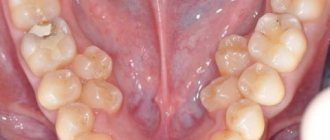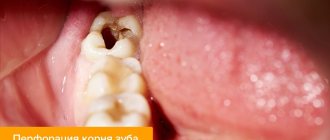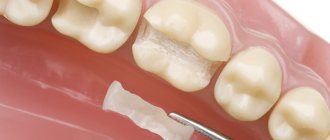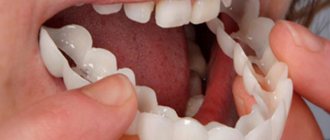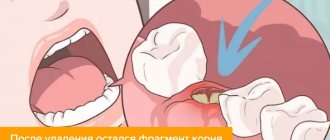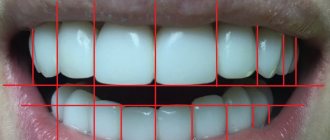Features of treatment of anterior teeth
The four incisors in the center of the upper and lower jaws are the front teeth. They are capricious, with a thin layer of enamel and dentin, caries strikes them quickly. Therefore, at the slightest discomfort, run to the dentist!
The front teeth are a very important area not only for the patient, but also for the dentist. They are always visible; everyone will notice errors in treatment. Incisors require jewelry precision from the dentist; the enamel is thinner, so the patient experiences more pain. Don’t forget about aesthetics - an incorrectly chosen filling color or poor degree of transparency will ruin the entire treatment.
The smile area requires special care. Observation should be made for crowded front teeth that overlap each other and are too large. The lack of vitamins in the body primarily affects the incisors - vitamin deficiency does not cost anything to undermine the already thin enamel. Food that often gets stuck in the interdental spaces warns of impending caries. It is better not to delay your visit to the clinic where front teeth are treated in Moscow: at the very beginning, caries is treated without the use of a drill.
Dental treatment
People have suffered from toothache since ancient times. There is evidence that attempts to relieve patients from this excruciating pain were made as early as nine thousand years ago. However, more detailed information dates back to the Middle Ages. It is interesting that the poor inhabitants of Europe, judging by the remains found, practically did not suffer from caries: strong jaws with healthy teeth were found in their skulls. Scientists suggest this is a consequence of the fact that the poor ate mostly solid raw food - vegetables, fruits, and delicacies were not readily available to them. As for the rich Europeans who lived in the Middle Ages, they ate completely different dishes: they avoided rough food, preferring broths and sauces. For example, the court ladies of the time of Louis XI tried to eat exclusively soups; it was believed that chewing efforts caused the early appearance of wrinkles on the face. Of course, their jaws were undeveloped, and their teeth hurt quite often.
How did dental treatment take place in the Middle Ages? It was entrusted to the most educated citizens, i.e. monks and barbers. The problem was dealt with using dental prosthetics: if rinsing, spells and prayers did not help, then the diseased tooth was simply pulled out, putting in its place an artificial one, which could be made of wood, pearls or silver. The new tooth, without further ado, was screwed to the neighboring ones using wire. Sometimes even dog or pig teeth were inserted.
Fig 1. Fig 2.
Fig 3. Fig 4.
Fig. 1, 2: This is how teeth were “drilled” in ancient times.
Figure 3: Pakistan, 7500 years ago. Traces of “dental” intervention are visible on the tooth.
Figure 4: An attempt at dental prosthetics in ancient Egypt.
Until the 18th century, people were convinced that dental problems were caused by “tooth worms,” which eat away the tooth from the inside. These evil creatures were fought seriously: teeth and gums were heated with iron, molten lead, wax or acid was poured into hollows. However, the most common method of dental treatment was removal - naturally, without anesthesia.
In Russia, Peter the Great was very fond of pulling out the teeth of his courtiers. It is said that the king always carried tools with him in order to be ready to “provide assistance.” He did it quite skillfully.
Gentle methods of dental treatment began to develop only in the middle of the 19th century, when the first anesthesia and real dental equipment appeared. The foot-powered drill was invented in 1870 in the USA.
Ether as an anesthetic was first used for tooth extraction in 1846. And since 1884, when Carl Colle used cocaine for anesthesia, patients began to line up in huge queues to have their diseased teeth removed.
Later they learned to make artificial teeth, reminiscent in appearance of real ones, but, nevertheless, far from perfect, from porcelain, which is fragile, or ivory, which quickly turned yellow.
Dental diseases, their signs and treatment methods
Today, dentists use modern methods that allow medical procedures to be carried out not only effectively, but also with virtually no pain. Among the most common dental diseases is caries, which, if not treated in time, can develop into pulpitis and periodontitis.
Caries is a disease that affects the vast majority of the inhabitants of our planet - 70-98% of all people. With this disease, the tooth itself is destroyed, i.e. its hard tissue, and a cavity appears in the tooth - colloquially a “hole”.
The main reason for the development of caries is the effect of pathogenic microbes found in food debris that makes up dental plaque on tooth tissue. After microbes process the carbohydrates that make up plaque, lactic acid is formed, which destroys dental tissue, demineralizing it. As a result of the destruction of mineral components, enamel and dentin soften, after which a cavity forms in the tooth.
Carious cavities in teeth.
Treatment of caries involves filling the cavity that appears in the tooth. The earlier this process begins, the more effective and painless the treatment. However, unfortunately, most people turn to the dentist only when the cavity has reached alarming proportions and the tooth is almost destroyed. It is not always possible to save a diseased tooth; in some cases, its remains must simply be removed.
Stages of caries treatment.
Often a big problem grows out of a small hole - caries is complicated by concomitant diseases. If a person begins to suffer from a sudden acute toothache, most likely, inflammation of the pulp has occurred - essentially, the nerve of the tooth, or rather, a bundle of nerves and blood vessels. This disease is called pulpitis. In normal condition, the pulp is “hidden” deep inside the tooth, under the protection of hard tissue. If a tooth begins to decay, microbes gain unhindered access to the pulp, actively “working” on its inflammation. The patient begins to feel sharp throbbing pains, which do not always go away even after taking strong painkillers.
Dental treatment for pulpitis involves removing the inflamed pulp, after which a specialist fills the canal and installs a filling in the tooth.
Filling the root canals of teeth in the treatment of pulpitis.
It happens that even severe pulpal pain does not force a person to see a doctor. After some time, the patient notices that the pain has subsided, and is incredibly happy about this! However, this is a big mistake, since not a single tooth will heal on its own. If the pain ceases to be felt, it means that the inflammation has gone even further - beyond the diseased tooth, into the tissues that surround it, i.e. in the periodontium. Inflamed periodontium “gives” the sufferer a new complication – periodontitis. And while the patient is thinking about where to treat his teeth, the pain returns and intensifies; it becomes especially unbearable if you accidentally press on the aching tooth.
Inflammatory changes in the bone tissue of the jaw during periodontitis
In this case, there is no way to avoid a visit to the dentist. A specialist who treats teeth for periodontitis will remove the inflamed pulp located in the root canals. The development of periodontitis is accompanied by infection of the tissues of the tooth root, as well as the periodontium itself. This means that dental treatment for periodontitis involves particularly thorough antiseptic treatment of the root canals.
Quite often, periodontitis leads to the destruction of the jaw bone at the apex of the tooth root. If this happens, it is necessary to repeatedly inject drugs into the inflammatory focus through the root canal. This type of dental treatment can sometimes take up to several months. When the doctor notices a decrease in the size of the inflammatory focus, root canal filling can be performed. If the administration of medications does not produce a positive effect, there is nothing else left to do but remove the diseased tooth.
Filling the root canals of a tooth Stage of treatment of periodontitis using the method
in the treatment of periodontitis . drug removal .
Methods for restoring damaged teeth
To restore a tooth destroyed due to caries, specialists use several methods.
Most often, a damaged tooth is restored using a light-curing filling. This method is suitable for cases where small volumes of hard tissue are destroyed - approximately up to 1/3. More extensive damage must be restored using other methods - using a ceramic inlay. It is worth noting that today ceramic inlays are considered the highest quality way to help give a damaged tooth its original appearance. Most often they are used to “repair” chewing teeth.
For the restoration of front teeth, it is advisable to use veneers, which, like inlays, are made of ceramics and belong to the group of dental microprostheses - structures that are installed to restore a damaged area of a tooth.
Fig 1. Fig 2.
Fig 3. Fig 4.
Fig 1: Ceramic veneer. Figure 3. Inlays on a plaster model.
Fig 2: Ceramic inlays. Figure 4: Inlays fixed to the teeth.
Modern dental technologies are replacing the recently popular methods of dental restoration, for example, the use of composite fillings.
Often patients consult a doctor whose crown part of a tooth is destroyed by more than half. In such cases, to restore the tooth you cannot do without an artificial crown. The patient has the opportunity to choose the most suitable option for himself - metal-ceramic or not containing metal elements. The second option is becoming more and more common today - it is a crown without a metal frame. Most dental clinics offer their patients several types of all-ceramic crowns. They differ from each other in details, but the positive qualities remain unchanged: aesthetic properties, hypoallergenicity, and long service life.
Artificial metal-ceramic crowns
Metal-free (all-ceramic) artificial crown
Prevention of dental diseases
The most effective way to prevent dental disease is still thorough oral care. Two hours after eating, plaque consisting of food debris begins to appear on the teeth. If it is not removed in time, the destruction of hard tissue, inflammation of the gums, and an unpleasant odor will begin. If you continue to neglect your oral hygiene, you run the risk of developing caries and other serious dental problems.
To prevent this from happening, you need to thoroughly brush your teeth at least twice a day with toothpaste and a high-quality brush. In addition, between meals, it is recommended to rinse your mouth with special liquids and use dental floss.
You should visit your dentist twice a year to have a specialist perform a preventive examination and remove plaque and tartar. If these conditions are met, the disease can be detected at an early stage, which means that dental treatment will be effective and painless.
Treatment methods – from filling to implant
The dentist will select the treatment method for the front teeth after an examination.
- Veneers or Lumineers
If the incisors are severely damaged, thin overlays can be placed - veneers or lumineers. They will hide the consequences of caries and make teeth whiter and smoother.
- Dental crowns
If only the root remains of the front tooth, intra-root inlays are made; this is the basis for the crown. Metal crowns are not suitable for front teeth; they will be too noticeable. To make an artificial tooth as similar as possible to a real one, it is better to use ceramic and zirconium crowns.
- Bridges and implants
If desired, missing front teeth can be replaced by bridges and clasp dentures. If funds allow, you can install an implant and forget about the problem for many years.
What can modern dentistry do?
Zirconium crowns installed today most often meet all the requirements for restoring the aesthetics and functionality of teeth. How long does the recovery effect last? This question is difficult to answer unequivocally, since much depends on dental care, nutrition and lifestyle of the patient. It is possible to prolong the effect of restoration by taking preventive measures given by the doctor after the dental restoration procedure.
The best dentists and dental clinics in Moscow offer high-quality dental crowns, reviews of which can be read on the Internet. It is important to understand that the benefits of implantation, dental care both before and after restoration is a determining factor in the health and whiteness of teeth. A fairly common problem for modern people is darkened enamel. Videos of dental crowns in dentistry can be viewed on the website. The reasons for darkening of the enamel are numerous, but in some cases it is impossible to correct the color defect with the help of bleaching. And this is where aesthetic dental restoration comes to the rescue, prices that can cope with even the most complex cosmetic tasks. Of course, the cost of implanting chewing teeth, as mentioned above, is affordable; it is very difficult to distinguish the tooth being restored on your own, even in the photo. Dental problems that can be easily treated by modern dentistry are quite numerous.
Among the most popular are diastema (interdental spaces), broken teeth, chips, cracks in teeth, stains and darkened areas on the enamel, “yellow” teeth, as well as other aesthetic problems on the front and side teeth. The service life of crowns and restorations allows you to solve numerous aesthetic problems, even in cases of significant destruction of the tooth or teeth. It is important to note that when several front teeth are destroyed, complete restoration is possible in the absence of contraindications to restoration. The choice of implantation technique, as well as the choice of implant system and the choice of crown system, is best left to the doctor.
Treatment of caries of anterior teeth
The main method of treating caries in the front teeth is filling. When it comes to incisors, in the language of dentists this is called very beautifully - artistic restoration. It is better not to save on the cost of the filling. High-quality material will last longer and will not spoil your smile. The front teeth are always visible, so the dentist has to select the color and degree of transparency of the filling with pinpoint precision; it must match the shade of the tooth as closely as possible. Reflective composite materials do not spoil the aesthetic appearance. Over time, light fillings do not darken or wear off.
Restoration method - one-stage implantation immediately after root removal
Single-stage implantation of a front tooth involves immediately installing an implant into the socket after tooth extraction. For this type of implantation, special dental implants with aggressive threading and a high degree of primary stabilization are used. On the same day, immediately after implantation, a temporary plastic crown is installed. This implantation allows you to solve two problems - removing a broken tooth root and closing a cosmetic defect. In addition, the method allows you to save a little, because... Some manipulations are not performed (for example, the gum former is not installed).
After 3-4 months, when osseointegration of the implant is complete, permanent crowns are installed. Just as in the case of conventional crowns, from an aesthetic point of view, the best solution for the front teeth is the use of ceramic crowns and, accordingly, abutments. It is preferable to install the crown on a zirconium dioxide abutment, then in any type of lighting the crown will not stand out from the general row of teeth. In our opinion, this option for restoring a broken front tooth is the most optimal.
Crack on front tooth
The front teeth always get the most damage. When they “punch you in the teeth,” the blow usually falls on them. They fell unsuccessfully, worried, chewed a pencil, or, horror of horrors, chopped nuts with their incisors, and now a crack appeared on the front tooth. By the way, it can occur without mechanical damage - for example, due to temperature changes. Teeth don't really like iced coffee. You shouldn’t overuse citrus fruits or their juices either, and it’s best to dilute freshly squeezed juices with water to reduce their acidity. You should not get carried away with whitening procedures, and be more careful with abrasive pastes. Cracks are also different.
Vertical
If you are “lucky” and it is small vertical, then nothing bad will happen to this tooth, and the defect will be barely noticeable. In this case, many dentists do not recommend loading the tooth with patches. But you still need to keep an eye on the crack. If it increases, the enamel changes color, and the tooth reacts sharply to hot/cold, sweet/salty, you should consult a dentist. The enamel will need to be restored and strengthened. The crack will be treated with a special compound containing calcium and fluorine. After the course of treatment, the tooth will react normally to food and become more even and smooth.
Horizontal
But horizontal or oblique cracks in the front teeth are a cause for serious concern. They provoke the formation of caries, chips and can generally lead to tooth loss. Treatment depends on the size, depth and location of the crack, as well as the characteristics of the enamel. If there are many microcracks on the tooth and the color of the enamel has changed, the doctor may suggest installing veneers, but only after treating caries and other oral diseases. A crack left unattended will permanently split the tooth. Then there will only be one treatment option left - prosthetics.
What teeth can be restored?
In dental practice, it is customary to consider those crowns that are missing more than 50% of their parts as a result of:
- carious lesion;
- mechanical injury;
- the presence of old fillings that do not collapse on their own, but caries develops underneath them;
- depulpation, against which the crown becomes fragile and changes color;
- increased abrasion of dentin, etc.
If you do not seek help from a dentist in time, restoring the unit will be problematic.
Loose front teeth
Loose front teeth are a wake-up call. Often this trouble happens with the front teeth. The main cause of looseness is gum disease: periodontal disease, stomatitis, gingivitis. You should not run them, otherwise you may end up without teeth at all.
The doctor will select the treatment for loose teeth individually. If the swaying is accompanied by pain, the teeth deviate significantly to the sides, the dentist applies special splints, removable or non-removable, to the incisors. Splinting strengthens mobile teeth, prevents their loss, and allows periodontal tissues to recover. In severe cases, surgical treatment cannot be avoided. During surgery, the surgeon removes bone tissue or restores it using metal shunts.
Cysts in the tooth canal and granuloma have a bad effect on the roots, and the teeth begin to become loose. These tumors need to be removed. If the tooth begins to loosen after a blow or injury, it is better to go for an x-ray.
Causes of tooth decay in adults
A trip to the dentist will show what exactly weakened the teeth: one serious illness or a combination of different factors. The most common causes of tooth decay in adults include:
- Heredity.
“Bad” genetics is expressed by:
— in the incorrect structure of the jaw, which causes constant friction of the teeth;
— in the composition of saliva, which does not protect teeth from pathogenic bacteria;
- in a small thickness of enamel.
These features, as well as a predisposition to caries, are inherited. Adults with dental problems need to have their deficiencies corrected in a timely manner. This will reduce the risk of transmitting dental “illnesses” to children.
- Chronic diseases.
Diabetes, various forms of oncology, hypertension, as well as problems associated with the functioning of the thyroid gland, gastrointestinal tract (gastritis, ulcers), etc., weaken the immune system and damage teeth.
- Taking certain medications regularly.
People who regularly use medications and certain drugs (hypnotics, sedatives, antihistamines) should pay special attention to the condition of their teeth. A high concentration of a number of medicinal components increases the level of acidity, changes the composition of saliva, which affects the strength of teeth.
Lack of vitamin D is one of the reasons that weakens enamel
- Avitaminosis.
Vitamins must be supplied to the human body regularly and in sufficient quantities. This primarily concerns vitamins B, C, E and vitamin D.
A deficiency of any component initially affects one’s well-being: rapid fatigue and constant drowsiness occur. Then it is reflected in appearance. Brittle hair, dry skin, cracks in the enamel are clear evidence of a lack of vitamins in the body.
| Groups of vitamins | What does it affect? |
| Vitamin A | The work of the salivary glands, the condition of the periodontal tissue. |
| Vitamin B | Participates in metabolism, affects the growth and development of muscles and tissues. |
| Vitamin C | Prevention of tartar, strengthening of gums. |
| Vitamin PP | Improves amino acid metabolism, prevents inflammatory processes. |
| Vitamin K | Affects the growth and development of tissues and protein function. |
| Vitamin D | Promotes the absorption of fluoride and calcium, increases the strength of bone tissue. |
Improper nutrition leads to vitamin deficiency. You should avoid monotonous food, do not get carried away with flour products, refined grains, and soda. The diet should include solid foods (cheeses, legumes), as well as cottage cheese, kefir, vegetables and herbs.
- Pregnancy and hormonal imbalances.
The development of the fetus and the formation of the baby’s bone structure provokes a deficiency of useful components, primarily calcium. Without it, the enamel will not be strong.
In addition, the following factors lead to tooth decay for the expectant mother:
- stress;
- poor hygiene;
- heredity.
Pregnant women are always recommended to avoid conflict situations, adhere to a balanced diet (vitamins and microelements must be present in the diet), and take walks in the fresh air more often.
Hormonal imbalances that occur due to illness or age-related changes (puberty, menopause) also disrupt the healthy balance of the body. This affects the teeth due to changing acidity levels.
- Bad habits. Bruxism.
Smoking and drinking alcohol slow down metabolic processes. Slow metabolism negatively affects the entire body, and in particular the oral cavity.
Bruxism is the name given to involuntary grinding of teeth, most often occurring during sleep. The habit is determined by the characteristics of the bite and the functioning of the nervous system. It continues, as a rule, until the teeth “ruze” against each other.
The solution in this situation is to wear mouth guards - caps that protect the teeth.
Silicone mouth guards will help prevent involuntary teeth grinding at night
- Injuries.
Tooth decay in an adult is often a consequence of injuries of various types:
— mechanical: bruises or other injuries caused physically, including during treatment;
- chemical, related to the external environment, with the amount of harmful substances contained in it;
— thermal, when there is a sharp transition from cold to hot or vice versa (the most striking example is coffee with ice cream).
- Malocclusion.
Due to a long-standing injury, treatment, or due to developmental characteristics, a person may develop an abnormal bite, in which the load on the teeth increases and they begin to “wear” against each other. This problem is solved comprehensively, with the participation of an orthodontist.
The list of other common causes includes poor quality dental care, natural aging of the body, complex forms of caries and poor ecology.
The habit of chewing nuts or crackers thins the enamel and causes teeth to crumble.
If your front tooth hurts after treatment
Patients often complain that their front teeth hurt after treatment. The dentist cleaned the canals, so this is normal. The discomfort should go away within a few hours. But if the treatment is done poorly, the tooth may hurt for a long time - and this is already a deviation from the norm. Most likely, the doctor made a mistake during treatment and the entire filling process will have to be repeated. The cause of pain can be a burn of the pulp, damage to the enamel, an allergy to medications, or acid contact with dentin.
How much does front tooth treatment cost?
The cost of treatment depends on the method and materials used. When it comes to the smile area, it is better not to skimp. In this case, prudent patients often have to remember the stingy man who pays twice. Choosing cheap materials often leads to aesthetic flaws, disappointment and repeated treatments.
As a rule, prices for treatment of front teeth in Moscow start from 2,000 rubles. For example, the cost of caries treatment without drilling ranges from 2,000 to 5,500 rubles. A light seal costs from 1,500 to 10,000 rubles. The price tag for splinting loose front teeth starts from 2,800 to 7,000 rubles. Removing a cyst will cost 7,000 - 37,000 rubles, granulomas - from 5,000 to 40,000. A dental inlay will cost from 5,200 to 20,000 rubles. Prices for veneers start from 5,000 rubles, lumineers - from 40,000. The range of prices for zirconium crowns is from 13,500 to 40,000, ceramic - from 17,000 to 57,000. Clasp prosthesis will cost from 29,000 to 73,000, dental implantation - from 30,000 to 120,000 and more.





